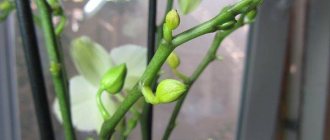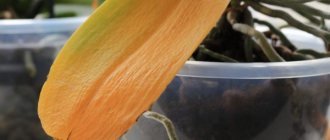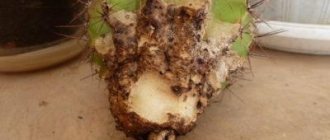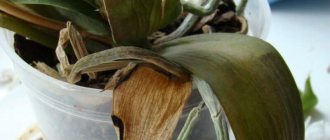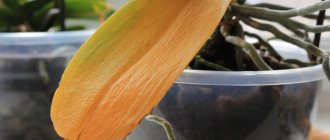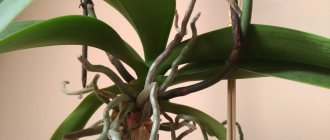How to care
Let's consider the features of caring for an orchid and its maintenance after flowering.
Lighting
In winter, there is not enough natural light in our area. Therefore, in order for the orchid to feel normal and be able to recover well during the dormant period, it needs additional lighting. If the plant does not have enough light, its leaves will stretch out, turn pale, and the next growing season will be in big doubt.
The artificial lamp should be placed at a height of 20-30 cm from the flower. Do not use a lamp that is too powerful: 60 W will be enough.
Temperature
Hypothermia of a delicate flower should not be allowed. If the pot is on the floor, place a stand under it, if on the windowsill, make sure that the flower is not close to the window,
Humidity and watering
During the dormant period, the orchid's need for moisture is significantly reduced. Watering should be reduced and the soil should be moistened only as it dries. The standard frequency of watering at this time is once every 10 days. It is not worth spraying the orchid in the cool season, as the procedure can lead to rotting of the vegetative part of the plant.
Top dressing
During the dormant period, the orchid is fed rarely - no more than once a month, or even less often. The fact is that in winter the plant absorbs the applied fertilizers much more slowly, since the metabolism in its tissues is inhibited.
Important: if the plant needs replanting, it is best to carry out the procedure immediately after flowering
The purpose of the flowering shoot
The peduncle is the appendage on which inflorescences are formed. The orchid throws out such an arrow immediately after the end of the dormant period, when the flower has rested and gained strength. After the peduncle is released, the flowering phase begins: ovaries are formed, which later grow and bloom. This is where the mission of the flower stalk ends.
Important! You should not trim the flowering arrow immediately after flowering. When it is strong and green, new inflorescences may soon appear on it.
Causes of drying out
If your orchid's flower stem is drying out, it may be due to the natural end of the flowering phase. But among the key factors causing this effect are a lack of nutrients in the soil and, in general, poorly organized care. In order to be able to prevent the peduncle from drying out in the future, it is worth considering the causes of this problem in more detail:
bad light. As a rule, the gardener faces difficulties with natural light in the autumn. Daylight hours are gradually decreasing, but the orchid still needs to be nourished by the sun's rays, otherwise its development process will stop and it will dry out. That is, it will be able to form a peduncle, but further blooming of the buds will no longer be possible. In addition, over time, the peduncle itself will begin to turn yellow, dry out and wither.
Remember one more important factor: you should not rotate the plant pot and try to make the natural light uniform. This will be regarded as a stressful situation, so the orchid may react completely differently than you would like
In some cases, the plant sheds a dried peduncle; inappropriate temperatures. To ensure an optimal microclimate for the orchid, you need to ensure that the temperature does not fall below +14 degrees and does not exceed +40 degrees. Hypothermia will not have the best effect on the plant. If you place a flowerpot under an air conditioner or ventilate the room too often and for a long time in winter, the flower stalk will begin to fade. Do not forget also that sunstroke, that is, overheating of the orchid, contributes to the withering of unopened buds. In addition, they will simply dry out; dry air. A drying peduncle of an orchid may be a consequence of an excessively dry indoor microclimate. First, you will notice how the overall tone of the plant deteriorates, and then the unopened buds will begin to dry out; lack of soil nutrition. A deficiency of substances such as magnesium, phosphorus, potassium and boron does not have the most favorable effect on the quality of flowering and the formation of peduncles.
If the peduncle of an orchid completely dries out, there may be several reasons for this. Review the features of the care you provide for your indoor plant - perhaps you made mistakes somewhere. In any case, the situation can be corrected. The main thing is to discover the source of the problem and then act.
Epiphyte problems
Doesn't release an arrow
If all care requirements are met, the orchid blooms once a year (maybe more often). Why sometimes doesn’t she put out a peduncle? There are a number of reasons for this. Insufficient lighting, incorrectly chosen substrate, lack of fertilizing, stressed state of the plant, improper watering - this is a list of the main negative factors affecting the condition of the epiphyte, and, consequently, its desire to bloom.
If the orchid does not have enough lighting, then it does not produce a peduncle, but increases the mass of leaves. And when a peduncle appears, buds do not form on the shoot. The way out of the situation is simple: increase the volume of light, but avoid direct sunlight
In the summer, it is important to remember about shading the plant. If the substrate is chosen incorrectly or the plant is not fertilized, then the gardener does not need to harbor hopes of seeing his beauty bloom. It is important to remember that the epiphyte loves moderation in everything: an excess of fertilizers can also negatively affect the condition of the plant. For feeding, it is better to use complex preparations intended only for orchids and purchased at a flower shop
For example, “Kemira Lux” or “Bona Forte”. Before use, be sure to read the instructions for these fertilizers. The same applies to the substrate: for planting or replanting an orchid, soil is used that is intended only for this flower.
Stress has two opposite sides. Sometimes experienced gardeners give their orchid “shock therapy” so that it produces a peduncle (cold, drought, darkness). But stress can have a detrimental effect on a flower. Be sure to remember that everything is good in moderation. Watering an orchid is one of the basics of flowering. Moisture affects the formation of future peduncles and buds. If the epiphyte is watered excessively, the root system will certainly begin to rot and the buds will dry out. During the growing season, watering should be systematic, and after the buds appear, the frequency of watering is usually reduced. For the appearance of a peduncle, it is recommended to place the container with the orchid in a water bath for 1 hour; during the dormant period, watering stops completely.
Humidity. Orchid is a tropical plant that loves moist air. But not during the period of release of the peduncle. The humidity level in the room where the epiphyte is located should not exceed 30% - 40%.
From the video you will learn why an orchid does not produce a peduncle:
The arrow is released, but does not develop
Sometimes the flower stalk stops growing; there may be a number of reasons for this, which are almost identical to those listed above.
- Insufficient lighting. The solution is to move the plant to a more illuminated place.
- Rotten roots. The solution must be radical: the plant needs to be replanted. And although it is not recommended to do this during the release of the peduncle, here we are talking about the life of the entire flower as a whole.
- Insufficient watering. The solution is to adjust the watering scheme. You can cover the top layer of the substrate with sphagnum moss, which will promote additional moisture and also change the acidity of the substrate, after which the peduncle can begin to grow again.
The period of growth of the peduncle - from the moment of appearance until the appearance of the first flowers - is usually about two months.
Dries up
Sometimes the almost grown peduncle begins to dry out. Why? Here are some main reasons:
- Reaction to transplantation. The plant adapts to the new substrate and “sheds” excess parts. As a rule, these are the peduncle and lower leaves.
- No difference between day and night temperatures. In bright sunshine, all metabolic processes in the orchid begin to accelerate, new cells begin to form, and for them the flower needs carbon. The supply of this element is replenished during the cool night time. If it is hot at night, the plant begins to experience a lack of carbon, and, therefore, takes what is missing from its old cells. The largest reserve of carbon is contained in the peduncle, so it dies.
- Lack of nutrients: nitrogen, potassium, phosphorus. They are also “pumped out” by the plant from its parts.
As a way out of this situation, experienced flower growers recommend cutting off the drying peduncle to living tissue. This can stop the drying out, and a new side shoot may grow from the dormant bud. If this does not happen, then the arrow will have to be cut off completely, leaving a stump of 1-1.5 cm, and wait for the next peduncle a few months later.
The orchid's stem dries up
Why did the orchid's stem dry out? It is necessary to correctly assess the damage and the cause of the drying of the stem, and begin to save the plant.
Causes of stem drying:
- By old age - if the plant is more than 6 years old, then this may be a natural phenomenon;
The stem of an orchid can dry out for various reasons. - Excess moisture when watering - most likely there is a problem with the roots, the roots need to be treated;
- Lack of moisture when watering - the trunk dries out due to a lack of nutrients supplied with water;
- Overfeeding with fertilizers.
If the trunk turns yellow and dries out for any reason, you must immediately begin treatment , otherwise the orchid will die.
The stems of orchid plants are divided into 2 types :
- Sympodial;
- Monopodial.
The first type of orchid plant grows like a raspberry , and has many stems growing from under the substrate. Such plants have many shoots (pseudobulbs), with the help of which the bush grows in width.
To this we can add that such an orchid has many growth points, and if one of them begins to dry out, then timely measures will save the adult orchid bush. And it continues to grow at the expense of other growth points.
With monopodial plants, such as Phalaenopsis, it is more difficult - it has only one growth point and if it loses it, then the bush can be restored only by demonstrating skill during resuscitation. When the drying stops, little babies will emerge from the stem.
This process will take the grower quite a lot of time, since babies on a shriveled stem may appear after 6 months , then it will take the same amount of time for them to grow. That is, the flowering of the rescued orchid will begin no earlier than in 3-4 years.
IMPORTANT! Drying of a monopodial stem can completely destroy the plant, and even rescue measures taken do not always help.
Features of pruning different types of orchids
Let's find out what to do with the arrow when the flowering of the most popular home orchids - phalaenopsis and dendrobium nobile - stops.
Phalaenopsis
When the phalaenopsis orchid begins to bloom, you should carefully observe the stem. If the arrow has completely dried out and turned yellow, it is completely discarded.
If it turns out that the arrow is still showing signs of life and does not lose its elasticity, most likely there is a chance of re-blooming in a few months. In this case, the peduncle is not completely removed, but only shortened, preserving the dormant buds. The good thing about shortening is that you don’t have to wait for the new shoot to be forced out during the next growing season - the old one will bloom. Phalaenopsis rests from two to six months.
Dendrobium Nobile
This orchid often requires replanting after flowering. The procedure is mandatory, especially if the flower is affected by pests or its roots have begun to rot.
The pseudobulb is completely removed if it is yellowed and dried out. If it is elastic and lively, it is simply shortened. Remember that the pseudobulb of this orchid accumulates a large amount of nutrients, so it is better not to touch it unless absolutely necessary.
To make dendrobium at home recover faster after flowering, place it on a southwestern windowsill and protect it from direct sun.
Other types
Other varieties of orchids require a similar approach. Cambria, cymbidiums and oncidiums are completely deprived of the flower stalk, since dormant buds in this case do not form on it after flowering. The same applies to the species Miltonia and Ludisia.
If we are talking about the paphiopedidium orchid, you need to wait until it completely sheds its buds and the peduncle dries completely. Only after this is pruning done.
Features of flowering
An orchid at home is ready to bloom when it reaches two years. By this time, if the plant is grown from a baby, it has already acquired at least six aerial leaves. A very important condition for high-quality and long-lasting flowering is the same location - the plant is conservative and has difficulty adapting to changes.
The flowering period lasts from the moment the buds open until they dry out. The buds open slowly, smoothly: first the upper and side petals, then the lower beard and the core. In total, the process of complete opening of one bud takes about a day.
After opening, the bud pleases with its beauty for 2-3 days. Then it fades. An interesting feature of the orchid is that the buds that are located closest to the end of the peduncle bloom first.
Methods for preventing and saving peduncles
If an orchid has dropped its flowers, what to do next depends on the cause and accompanying signs:
- If there is a lack of sunlight in autumn and winter, fluorescent lamps are installed, which can artificially extend daylight hours.
- If the green roots have turned gray, and there is no condensation on the walls of the container with the orchid, then the flower needs watering. The main thing is not to overwater or dry out the soil.
- If the stem turns yellow and the plant overheats, then it needs to be moved to another place away from the heating devices. This will save the orchid from dry air.
- If there is a high temperature in the room with the flower, then it must be sprayed. Periodic spraying of the entire stem will help the plant not to dry out.
- You should not leave the orchid in direct sunlight, otherwise burns will appear on the leaves. It is best to place the flower in a shaded place or make a barrier from bright light using reflective paper.
Fertilizer is equally important for every flower growing in pots. Without additional feeding, they will not be able to receive the necessary elements for development and will not bloom - there is not enough strength for this
It is necessary to feed the stem at the moment when the flower begins to grow green leaves and releases a flower arrow. If an orchid drops buds, you need to fertilize it in this way:
- leave it in water for a while so that the beneficial components are absorbed into the root system as best as possible;
- then dilute the fertilizer in water and keep it in this solution for another 20 minutes;
- After the time has passed, remove the container and allow the water to drain.
Attention! After feeding, you need to pay attention to whether the solution remains in the pan, because the accumulated liquid will burn the roots of the orchid.
Phalaenopsis does not like this, so you need to drain the solution every time it appears. Fertilize the plant with root fertilizers once every couple of weeks, and use foliar fertilizers between them, but the simultaneous use of both fertilizers is not advisable. If you use everything correctly and according to the instructions, then the fallen buds will be replaced with new ones.
Everyone who wants to buy a flower immediately becomes a fan of this plant, and some gardeners also collect different varieties. If the necessary conditions are not provided, the buds will soon disappear. To prevent the phalaenopsis from throwing off its last leaves, you need to carefully care for it, and then the orchid will become more and more magnificent.
The reasons why orchid flowers fall off have been clarified, as well as how to predict them. And in order for the plant to bloom again, you need to follow the rules of care: provide the necessary lighting, water and fertilize on time, and keep it in comfortable conditions.
How to properly prune an orchid after flowering - watching the peduncle?
If you don’t wait for this moment, you can simply destroy the plant.
Most often, two methods are used: pruning just above a dormant bud, or almost at the base. However, if you shorten the peduncle from above, the growth of new stems will be slowed down. This happens because the plant begins to spend all its incoming energy on the growth of new buds.
For pruning at home, it is best to use garden pruners. It almost does not injure the plant, does not create burrs into which harmful microorganisms can easily penetrate. Before use, it is advisable to boil the tool or treat it with alcohol. After the procedure, the cut site is lubricated with activated carbon or iodine. Some orchids have a hollow stem that can get caught in water when watered, causing it to rot. To prevent the death of the plant, the wound can be closed with beeswax.
The peduncle has dried out - should we remove it completely?
After the peduncle has fulfilled its function, all the buds on it dry out. In this case, the arrow must be completely cut off. The orchid itself dries out its outdated peduncle and there is no need to force events by trying to shorten it ahead of time. A capricious plant may even die from improper care. The nutrients contained in the drying peduncle will support the orchid and make it healthier.
Once completely dry, prepare for trimming. To do this you will need pruning shears or special garden shears. Pruning should be done as close to the rosette of the bush as possible. Afterwards, it is advisable to sprinkle the wound with cinnamon powder or charcoal.
Sometimes it happens that the peduncle begins to dry out not for natural reasons, but due to a lack of moisture in the soil. In this case, it is enough to start watering the orchid regularly, and soon it will bloom. If there is too much moisture in the soil, then the best way to quickly improve the condition of the plant is to replant.
This is interesting: soil for orchids
How to determine whether there will be re-blooming?
Many orchid owners strive to ensure that they bloom endlessly. Unfortunately, this cannot continue forever, because the plant needs rest. The chance of re-blooming increases with the presence of dormant buds. The appearance of new stems and buds will also be a good sign.
With certain care for the orchid, the likelihood of re-blooming can be increased:
- keep the temperature in the range from +17 to +22 degrees Celsius;
- move the orchid to a bright room, but do not expose it to direct sunlight;
- do not allow excessive soil moisture, it can lead to the appearance of rot and fungus;
- Apply fertilizers in a timely manner.
It has been noticed that in mature plants cases of repeated flowering are observed much more often than in young ones. An orchid that is older than 2-3 years is considered mature. And for plants that are too young, repeated flowering can even be dangerous; it is especially undesirable for dwarf breeds.
Cutting the peduncle not to the base
If the peduncle is completely dry, then it is cut off to the base. But in some cases this is not necessary and it can simply be shortened. If the orchid has already faded, but the frog remains dense and elastic, then it is not necessary to cut it off at the root. Examine her for dormant buds. If they are, then trim a little higher.
Later, a strong branch will grow from the dormant bud, and after a few weeks a bud will appear. Sometimes the wait for re-blooming can take several months. In order to stimulate the formation of buds, it is practiced to reduce the level of watering and alternate between higher and lower temperatures. In some cases, the cut peduncle dries out; this may be caused by improper implementation of the stem shortening procedure or the poor condition of the orchid.
Natural process
The part of the plant called the stem depends on the type of flower. For example, in phalaenopsis the stem is usually considered to be the peduncle, while in dendrobium it is the bulb. In order for an orchid to delight with new flowers and feel good, it requires proper care. Knowledge of the basic features of keeping them will help you avoid problems, namely, all Phalaenopsis are susceptible to new conditions and are afraid of changing their habitat.
Slightly yellowed lower leaves of phalaenopsis are considered common. Green leaves live for a certain period, namely from 3 to 5 years, after this period the leaf gradually becomes soft, fades, turns yellow, and soon dries out. It is also natural to see a situation where the faded stem of an orchid has dried up.
After the plant has produced buds, and then has flowered safely and dropped them only after 3-6 months, events can develop in two ways:
- the peduncle continues to be green and is preparing to bloom again;
- The stem is already yellow and needs pruning.
Most often, after acquiring a beautiful flowering phalaenopsis, you will notice that it begins to drop its flowers, the buds turn yellow, and then the orchid’s stem turns yellow. This suggests that the plant has suffered stress due to a change in conditions and place of residence. However, phalaenopsis quickly gets used to its habitat and soon grows green mass and roots. And then the growing season begins and soon the plant produces a new peduncle.
Slightly yellowed lower leaves of phalaenopsis are considered common.
If the orchid stem has turned yellow, you can cut off the yellowed stem completely or just to the next dormant bud.
- If the peduncle has dried out and turns yellow to a certain area, but is still partially alive, then the flower has decided to release a baby from a bud or a side peduncle. The side shoots do not bloom so profusely, so to speak - sparingly.
- Completely cut off the peduncle, which has already faded from the crown, so that their bush in the future will spend energy only on large and harmonious flowering.
Possible causes of orchid wilting and ways to save it
All causes of yellowing and wilting of orchid leaves can be divided into four large groups:
- unsuitable conditions for keeping the flower;
- improper care of the orchid;
- plant disease with infections;
- flower damage by pests.
Let's take a closer look at these reasons, find out how they affect the health of the plant, and find out what to do if the leaves or flowers of an orchid wither.
Incorrect conditions of detention
Being in direct sunlight. (overheating of roots) Orchid leaves first turn yellow and then dry out if unsuitable conditions are created for it. These include:
- Dry air. In their natural environment, orchids grow in tropical forests where it rains every day. Therefore, they are very demanding of moisture. If the air humidity is too low, the leaves begin to wilt. This happens especially often in winter, when the air becomes dry due to radiators and other heating devices. To save the flower, humidify the air. The simplest and most modern way to solve the problem is to buy an air humidifier. Also try placing the plant pot on water-soaked rocks or hanging a lot of wet laundry around the house.
- Low air temperature. In the tropics, the temperature stays at +20...+30 o C, and it never drops below +14 o C. It is difficult to maintain such a temperature at home, but it is necessary for the orchid to maintain the green color of its leaves. If you cannot increase the air temperature by heating the room, buy a heated mat and place a flower pot on it.
- Lack of lighting. The optimal length of daylight for orchids is 12 hours. If the lighting is poor, or the sun shines less than 12 hours a day, the plant suffers. Its leaves lighten and weaken. The solution to the problem is simple - place the flower pot in a well-lit place. Provide additional lighting in winter. Special phytolamps are most suitable for maintaining photosynthesis in plants. A cheap, but lower quality analogue can be a fluorescent lamp.
- Overheating of roots. If the orchid stands in direct sunlight, its roots overheat and die from the resulting burns. This is facilitated by the transparent walls of the pot. Dead roots do not supply nutrients to the stems and leaves, so the above-ground part of the plant withers. To save the flower, you need to cut off the burnt roots and replant the flower. Place the pot in a well-lit place with diffuse rather than direct sunlight.
- Incorrectly selected soil. For orchids you cannot use what we used to call soil. Flowers die in the soil mixture. Instead of soil, plant your tropical guest in a mixture of crushed tree bark, sphagnum moss and small stones.
- Draft. Orchids do not tolerate cold air currents. If they often stand in a draft, the leaves begin to turn yellow and fall off. Move the flower pot away from openable windows. Do not keep it near the air conditioner.
- Location in the kitchen or other place where vegetables and fruits are constantly found. If the flowers of your orchids dry out quickly, and some of the buds do not even have time to open, this may be due to the influence of ethylene gas. It is released by some vegetables and fruits. Move the flower away from them to admire the beautiful blooms longer.
An orchid can begin to fade, even if you have provided it with optimal conditions. This happens when there is a sudden change in microclimate. For example, if you bought a flower in a store and brought it home, or borrowed a plant from your neighbors. The difference in lighting, temperature and air humidity for such a sensitive flower will be significant. Therefore, he will experience stress. A temporary refusal to replant, regular watering, humidifying the air and feeding your green pet will help you get out of it faster.
What to do: step-by-step instructions
If the appearance of the plant does not leave much to be desired, then you should clearly analyze the conditions under which the flower is kept and take the necessary measures to stabilize the situation.
Is it worth pruning?
It is not recommended to cut a shoot that has just begun to turn yellow; wait until the sprout dries out. In this state, it will be easier to remove wilted shoots, minimally damaging the plants.
Experts and flower lovers with extensive experience recommend cutting off any shoots during the plant's hibernation period . For orchids this is the fall-winter season.
We invite you to watch a video on how to trim an orchid peduncle:
Do I need to replant?
Replant the plant at the first sign of suspected root damage, rot, or change in color of the root system.
When performing the procedure of replanting a plant, it is recommended to follow simple rules:
- carefully try to remove the plant from the pot without damaging the shoots;
- run the root system under running water at room temperature to clean them;
- if there are rotten areas or diseases, cut off the affected areas, treat them, and let them dry;
- prepare a new pot, soil mixture, drainage;
- complete the replanting process, then isolate the plant for a while, do not water it with a stream, carry out regular spraying and moistening.
Actions with dried shoots
- If the shoots turn yellow, remove only those parts that have turned yellow. When the flowering shoot dries out, it is better to remove it completely.
- After cutting off the dry parts, you should place the plant in a dormant state, limit or stop watering for a while.
